AI Tools For Software Development: What to Use, When, and Why
Published: – Updated:
When you search for “best AI tools for software development,” you’ll find dozens of articles comparing coding assistants, co-pilots, and IDE plugins.
Yet, most of these comparisons focus on which tool generates code faster or handles larger context windows more efficiently. They pit GitHub Copilot against Cursor or debate whether Claude beats ChatGPT for code generation. And at the same time, they completely overlook the planning, testing, deployment, and maintenance phases that comprise most of the work.
Let’s face the truth, AI software development tools come and go. Today, everyone is talking about Claude 4. Next month, it’ll be something else. But the software development process remains the same.
That’s why we’re skipping the “Top 10 best AI tools” lists and instead sharing our actual toolkit — the AI tools we use day-to-day, why we’ve picked them, and the lessons we’ve learned from implementing them on real projects.
Let’s walk through it step by step.
Project planning
The planning stage is critical in software development—without it, there are no clear user stories, defined features, or roadmap—just chaos.
Traditionally, business analysts spend hours on calls, researching, and manually translating client needs into actionable tasks for developers. Today, AI tools for software development help speed up these early-stage tasks, from summarizing stakeholder meetings to drafting requirements and aligning timelines.
Here are the software development AI tools our BAs rely on — practical, time-saving, and easy to use.
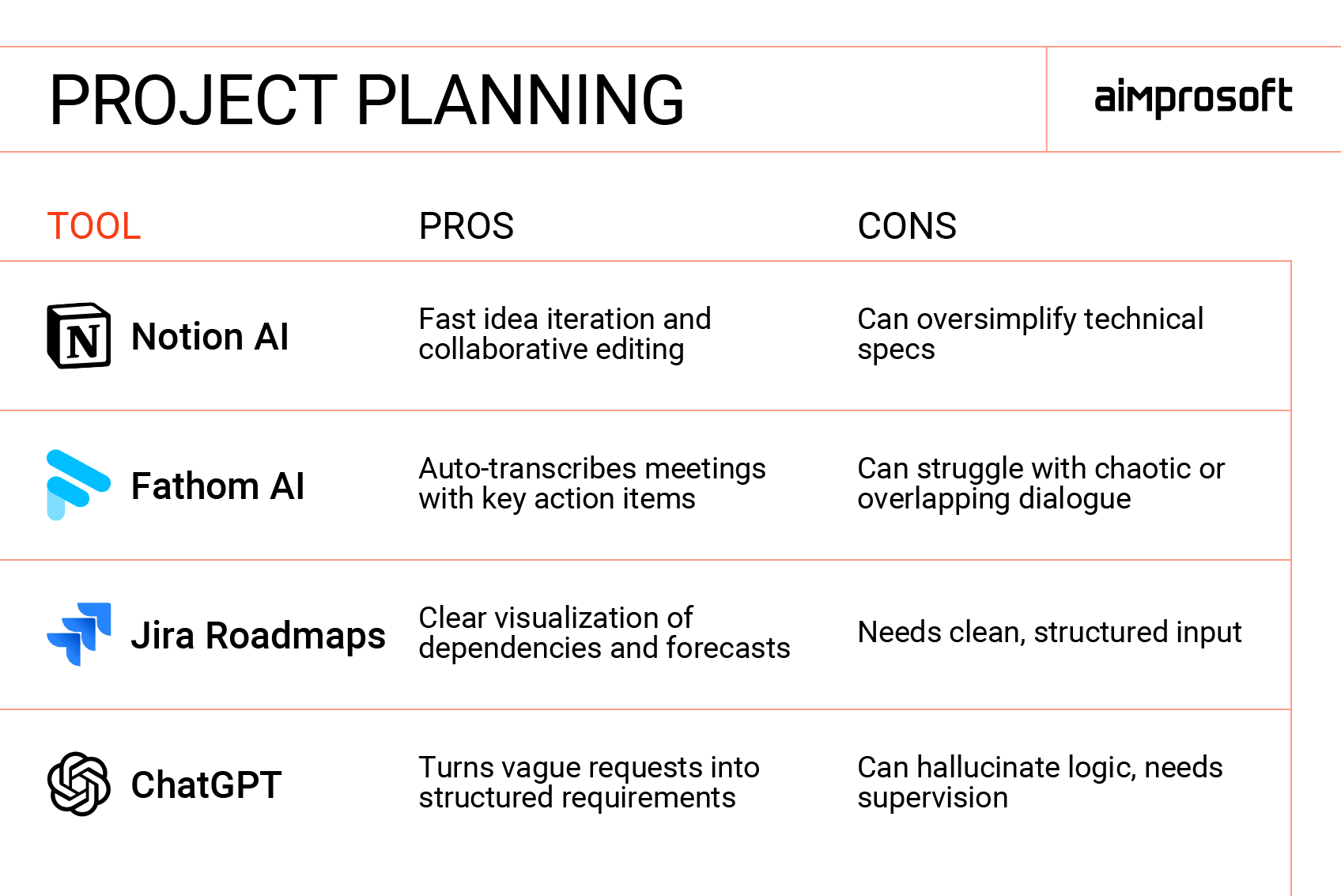
Notion AI
Use cases: Brainstorming feature ideas, drafting specs, rewording team notes.
Why we use it: Great for quick iterations and collaborative idea shaping.
Limitations: Can oversimplify technical or domain-specific requirements, requires review.
Privacy: Your notes are encrypted, securely stored, and managed in compliance with GDPR and other relevant data privacy regulations, with clear options for data control.
Fathom AI
Use cases: Transcribing meetings, extracting action items, identifying key discussion points.
Why we use it: Reduces time spent writing summaries and follow-ups; adds helpful sentiment analysis.
Limitations: Works best in well-structured calls; may miss nuances or overlap with conversations.
Privacy: Enterprise-grade protection (SOC 2, GDPR). Your call transcripts remain private, aren’t used for training, and won’t be shared with third parties.
Jira Advanced Roadmaps
Use cases: Visualizing dependencies, scenario planning, forecasting resource needs.
Why we use it: Scales well for complex backlogs and cross-team alignment.
Limitations: Requires well-maintained inputs to be effective.
Privacy: It can be self-hosted (e.g., AWS, Azure) for maximum control, which is ideal for enterprise teams with strict compliance needs.
ChatGPT
Use cases: Drafting user stories, refining epics, generating acceptance criteria, exploring vague requirements.
Why we use it: Perfect for turning “we need something that does X” into actual, actionable requirements.
Limitations: Can hallucinate or misinterpret domain logic, so keep an eye on it.
Privacy: ChatGPT doesn’t use your data for training, and you get full control over what’s stored — a safe bet for sensitive business input.
Now that you have a list of tools, let’s take a look at how we’ve applied them in practice.
AI use case: planning for education company
One of our clients, an education platform, was dealing with constant changes to project priorities. Their BAs were spending more time in meetings than defining clear requirements. We set up Fathom to automatically capture and transcribe their stakeholder calls, then used ChatGPT to extract user stories, test cases, and action items from those transcripts. Combined with automated README updates via Git hooks, this AI-driven software development workflow enriched 75% of their BA tasks with clear, structured business logic — turning chaos into actionable development work.
Product design. UI/UX design
Whether you’re creating wireframes, brand imagery, or product mockups, it’s easy to assume design starts with visuals. But in reality, most of the work happens long before that — with user research, competitor analysis, and mapping user flows that align with business goals. That’s where the foundation for good design is built.
Fortunately, generative AI tools for software development can support both research and visual creation. From helping with early discovery to suggesting UI layouts and generating visuals for marketing, they reduce creative bottlenecks and assist both designers and non-designers alike.
Of course, they don’t replace human judgment, especially when branding, usability, or accessibility is at stake. But for design projects, we’ve found these AI tools for app development really hit that sweet spot between speed and quality.
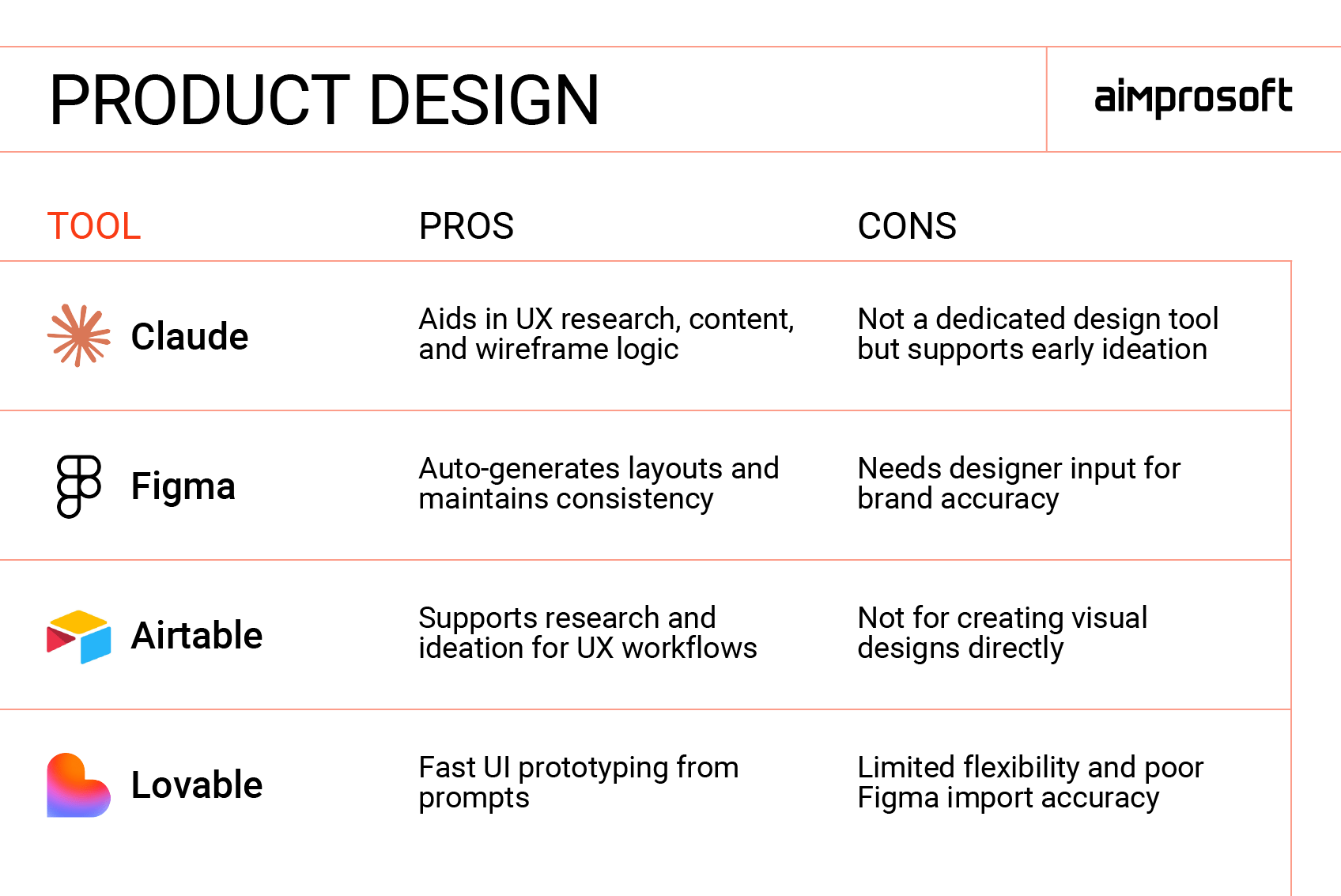
Claude
Use cases: Generating insights, competitor research, extracting information from SOPs and internal documents, surfacing hidden data in complex or niche domains.
Why we use it: Critical during the research phase, which accounts for 60–70% of UX work before design even begins. Helps understand the business context, user needs, and market landscape.
Limitations: In complex industries, Claude sometimes overgeneralizes findings and needs more cross-checking than other tools we use.
Privacy: Claude follows enterprise-grade privacy standards and doesn’t store or learn from your data. All processing happens in secure sessions, and your information stays private and isolated.
Figma (AI features)
Use cases: Suggesting auto-layouts, generating UIs, managing design systems, creating responsive variants, checking accessibility, and assisting with prototyping.
Why we use it: It helps designers iterate faster, generate multiple layout ideas, ensure accessibility compliance, and stay consistent with components. It’s also integrated into our daily workflows, making it a go-to for design ideation and refinement.
Limitations: AI features work well for basic layouts and early-stage concepts but require manual adjustments for complex user flows, multi-step interactions, and brand-specific visuals. Importing external templates or using third-party integrations may lead to inconsistency or extra cleanup.
Privacy: Your designs are encrypted and access-controlled. By default, Figma doesn’t use your files to train AI models. You stay in control of your designs and can choose to share data only if you want to.
Airtable
Use cases: Structuring product ideas, collecting insights, organizing design research, and building database-driven UI mockups. Also useful for cross-functional collaboration.
Why we use it: It helps manage research-intensive UX tasks, such as user interviews, competitor analysis, and workflow mapping. Useful for ideation before visual design even begins.
Limitations: It is not a design tool per se; it supports the planning phase, not interface creation. Requires integration with other tools (like Figma or Miro) for visual execution.
Privacy: Airtable complies with major data privacy standards (GDPR, CCPA) and offers granular user access controls and content deletion options.
Lovable
Use cases: Quickly generating basic UI screens and clickable prototypes from text prompts or simple inputs. Often used in pre-sales to create quick visuals without extensive design resources.
Why we use it: It’s helpful for producing rough UI ideas fast, especially when we need to show a client an interactive prototype in a short time frame. Ideal for basic landing pages or simple app flows.
Limitations: Templates are fixed; custom designs often get overridden to fit Lovable’s patterns. Imports from Figma don’t retain design fidelity. It doesn’t handle complex user flows or advanced interface logic well.
Privacy: Projects are stored securely, and user data is not shared externally. You can delete your designs anytime. Lovable doesn’t use your content for training without consent.
Now, back to real-world cases.
AI use case: design for an ambitious partner
A company with ambitious designs but a tiny development team. Their designers were creating stunning Figma mockups but turning them into working Vue.js components was eating up weeks of developer time. We introduced ChatGPT Vision to bridge that gap, automatically converting Figma designs into functional components with less than 20% manual fixes needed. How did that go? 80% faster UI builds that help them ship their MVP on time and maintain design consistency as they scale.
Product development
Coding is where most AI hype lives. Tools like Copilot, Cursor, and JetBrains AI can autocomplete functions, generate basic code, and even suggest whole components based on surrounding context. Yet not all tools deliver the same value — and some add more noise than help.
With so many options available, we focus on picking the right tools for the job, not throwing everything at every project.
Instead, we choose the best AI solutions based on what the client needs, the tech we’re already using, what the team has access to, and privacy concerns. The tools below are based on our real-world experience from different projects, offering practical insights rather than just comparing features.
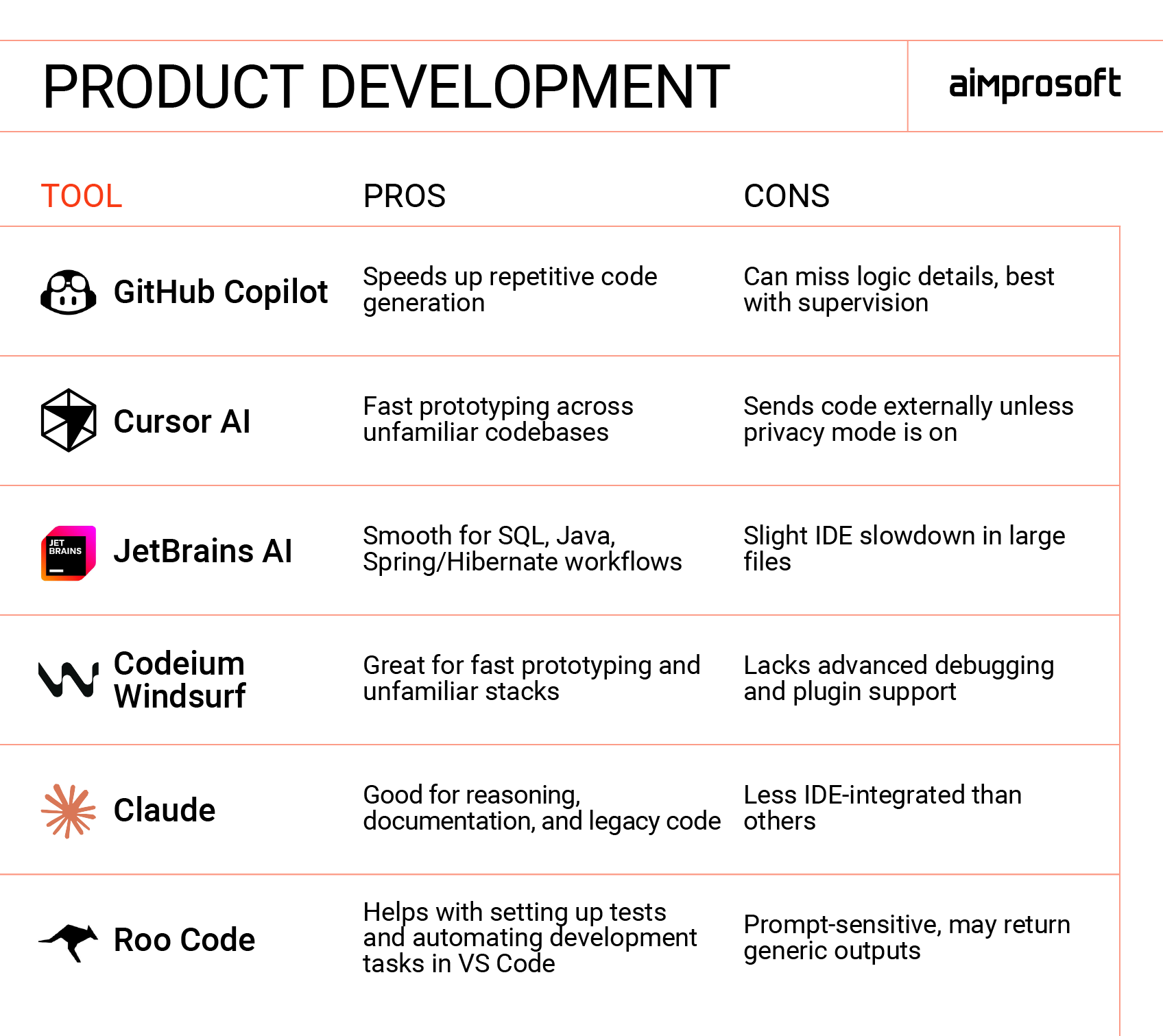
GitHub Copilot
Use cases: Completing code, suggesting documentation, and providing real-time inline coding help.
Why we use it: It’s great for generating repetitive code, like setup files or helper functions, and speeds up writing common patterns.
Limitations: May occasionally suggest code that closely matches snippets from public GitHub repositories, including code with restrictive or incompatible licenses. Requires active developer supervision to avoid potential licensing issues.
Privacy: Admins can manage Data Loss Prevention (DLP) policies to prevent data loss and exposure. In enterprise plans, your code stays private and isn’t used to train the model.
Cursor AI
Use cases: Quick prototyping, suggesting code inline, and supporting refactoring across large or unfamiliar projects.
Why we use it: When we’re switching between projects or tech stacks, it helps us ramp up quickly without missing key dependencies or breaking things.
Limitations: By default, Cursor analyzes your code by sending snippets to its servers, which may raise concerns for sensitive projects. Privacy Mode avoids this but can reduce suggestion quality.
Privacy: When Privacy Mode is enabled, all processing stays local and encrypted; none of your code leaves the machine.
JetBrains AI Assistant
Use cases: Completing code, generating boilerplate, writing SQL queries, and generating frontend and backend entities.
Why we use it: Deep integration into our JetBrains IDEs saves time on repetitive SQL and backend logic. This is especially useful when working with Java, Spring, and Hibernate frameworks, where code generation follows established patterns.
Limitations: Slightly slower and more limited in IDE performance compared to Cursor for some use cases.
Privacy: No data is used for training, and temporary storage is used solely for monitoring abuse.
Codeium Windsurf
Use cases: Autocompleting code, generating snippets for unfamiliar stacks, and quick prototyping in a separate environment.
Why we use it: Windsurf works best for us as a standalone IDE when we need to move fast outside our main toolchain. It’s lightweight, handles unfamiliar stacks well, and makes cross-file logic easier to follow when jumping between projects.
Limitations: Being a newer IDE, it may lack the mature debugging tools and plugin ecosystem available in VS Code or JetBrains, which can slow down more complex workflows.
Privacy: Private code is never used for training. Paid plans default to zero data retention. All telemetry is anonymous and opt-out is available.
Claude (used contextually)
Use cases: Long-form code reasoning, generating docstrings, reviewing logic, explaining legacy code.
Why we use it: Helpful when working with large files or full architecture pieces. We typically use Claude via the web or CLI tools like Aider, where it excels at reviewing broader context and untangling legacy logic.
Limitations: Less IDE-integrated than other tools used outside the development environment.
Privacy: Access-controlled, encrypted, and only trained on feedback if you explicitly submit it.
Roo Code (VS Code plugin)
Use cases: Refactoring code and helping with debugging steps. Running terminal commands directly from the IDE, such as installing packages and executing builds or tests.
Why we use it: It offers an integrated multi-agent assistant that can plan, implement, debug, and document tasks all in one seamless workflow. Supports a variety of model choices and custom modes (e.g., Code, Architect, Debug, QA) for tailored task automation.
Limitations: The quality of responses is highly dependent on promptness. Sometimes it provides overly generic outputs or suggestions that may not align with project-specific rules unless configured properly.
Privacy: Runs locally under your VS Code instance and only reads/writes files you permit.
As you can see, most AI coding tools assist engineers in coding, but it’s more than just lines.
AI use case: software engineering for a telecom leader
Ever tried managing dozens of microservices with a team that’s constantly shifting? That’s exactly what our partner was dealing with — developers jumping between services they’d never seen before, with documentation that was either missing or outdated. To help them solve this issue, we introduced GitHub Copilot to help with reviewing pull requests and creating issues. We also used Codeium Windsurf in our main coding environment to do the heavy lifting: generating code, drafting test cases, and keeping documentation in sync.
Six months later, development speed increased by 10%. By year’s end, they were moving 20% faster with documentation that stayed current.
QA and software testing
Testing is one of the most underestimated stages of software development. It’s tedious, time-consuming, and somehow always gets squeezed when deadlines loom. But skip it, and you’ll pay the price when users start abandoning your app because buttons don’t work or forms crash unexpectedly.
But with so much ground to cover, it’s natural for people to miss something. This is where AI can step in — helping generate test cases, spot gaps, and automate repetitive tasks.
In our work, we use a mix of dedicated testing tools and general-purpose LLMs to speed up testing without cutting corners. Here are some of them.
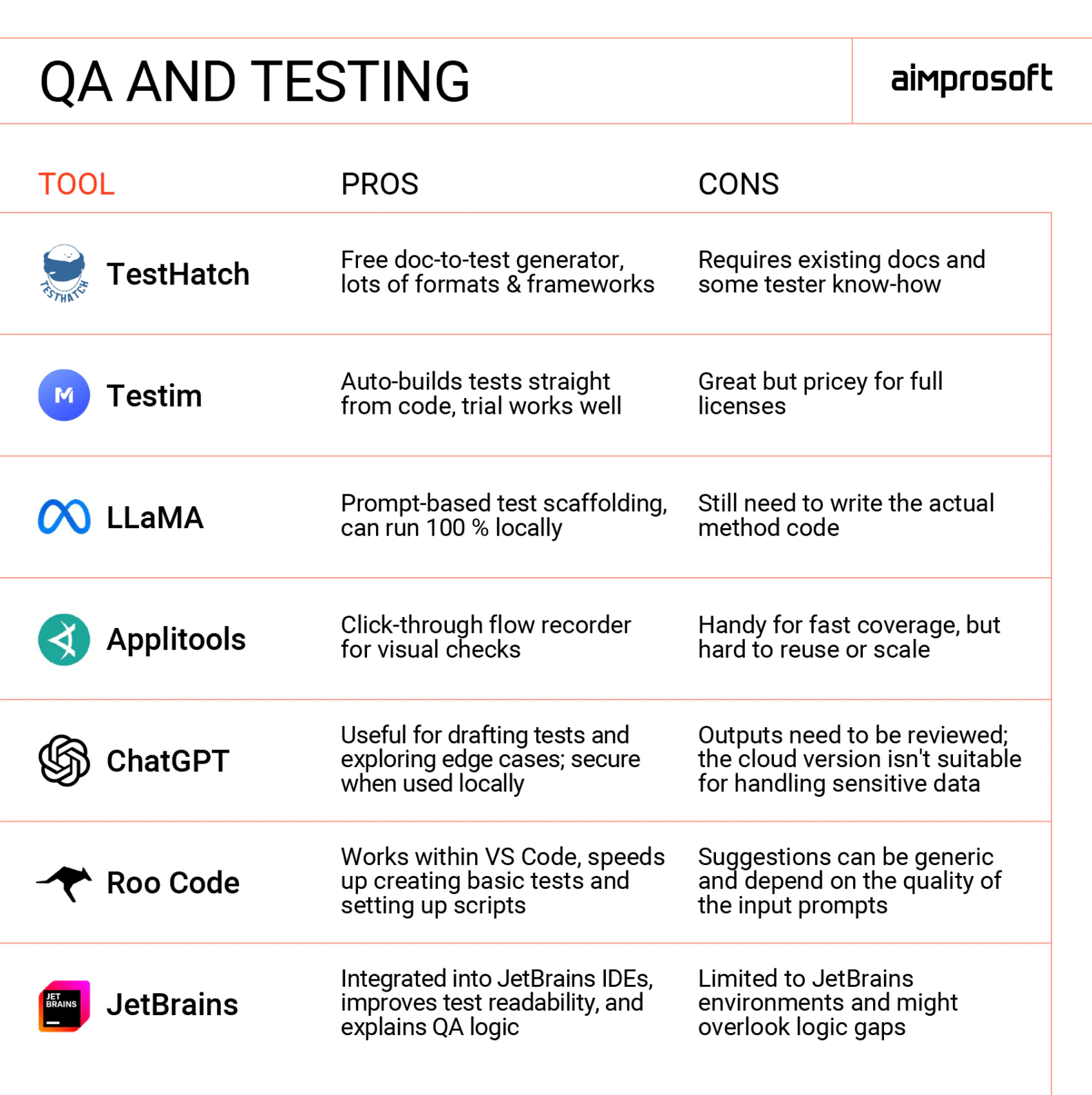
TestHatch
Use cases: Generating test cases from existing documentation like user stories or Confluence pages with described user flow. Creating test cases in your preferred format (detailed test plans, BDD, etc.). Organizing tests by feature, user story, or project. Generating automation scripts that work with various frameworks.
Why we use it: It’s totally free, which is rare for a tool this flexible. It supports a bunch of languages (Java, JavaScript, and more) and gives you lots of options for how to structure your tests. If you know what you’re doing, it can save you a ton of time on both test creation and setup.
Limitations: You need to have some documentation to start with (it doesn’t work well without input). And while it can generate a lot, you’ll still need to know how to use the output effectively to get full value.
Privacy: TestHatch follows GDPR and collects personal data only when needed for things like accounts or purchases. Your data is processed securely, and you can ask for its deletion anytime. Additionally, no AI features will use your data for training their models.
Testim
Use cases: Generating complete test cases directly from code, even without documentation. Creating automated tests with minimal manual input. Organizing tests and files into a structured format with little manual effort.
Why we use it: Testim is easy to use, even without technical skills. It’s great when there’s little to no documentation. It can scan your code and automatically build high-quality test cases — everything from test logic to file structure. Shows great results even on the trial version.
Limitations: It’s powerful, but the licensing costs are relatively high compared to other options, which can make it tough for smaller teams or budget-conscious projects to adopt.
Privacy: Tool follows industry-standard security practices. Data is encrypted during transmission and storage, but it’s still important to check terms before using it on sensitive or client-owned projects.
LLaMa 3.3
Use cases: Creating manual test cases from code or docs, then generating automated ones from those — with LLMs, the source doesn’t limit us. Great for speeding up the whole test creation process when time or resources are limited.
Why we use it: A cost-effective alternative to expensive tools. We created prompts that help us generate manual test cases first, then turn those into automated ones.
Limitations: LLMs don’t give you a fully working code. They’ll set up the test structure and file layout, but you still need to write the actual methods yourself.
Privacy: One of the big pluses is that LLaMa can be run locally, meaning no data ever leaves your machine. If you’re using it through a cloud provider, your data is encrypted in transit, but it’s always worth reviewing the terms, especially if you’re handling sensitive client information.
Applitools
Use cases: Recording user flows by clicking through a web app and turning them into step-by-step tests or documentation. Mostly focused on visual test coverage.
Why we use it: It lets anyone click through a user flow and automatically generate visual tests or documentation. Useful for quick coverage when there’s no time to write full test cases manually.
Limitations: The tool primarily focuses on visual recording and offers limited control over test logic and structure. Recorded scenarios are difficult to reuse or maintain, especially in complex setups. Overall, it feels closer to a smart screen recorder than a full testing solution.
Privacy: Applitools follow GDPR and ISO 27001 standards. It collects personal data only when needed (such as registration or demos), and users can request deletion at any time. Test data is encrypted both in transit and at rest.
ChatGPT
Use cases: Creating manual test cases from documentation, drafting automation logic, and exploring edge cases. Brainstorming QA scenarios before implementation. Exploratory and regression testing.
Why we use it: It’s flexible and supports fast idea validation. The local deployment is handy for enterprise-grade security, making it safe to use for internal or confidential tasks. Pre-written templates help generate test cases in the correct format quickly and efficiently.
Limitations: The cloud version isn’t suitable for sensitive data, and outputs always require review. Even visually appealing answers often contain logical flaws.
Privacy: It follows standard security practices, including encryption in transit and at rest, which makes it suitable for everyday tasks. But for anything involving sensitive or client-specific data, we recommend setting it up locally using OpenAI’s API on internal infrastructure.
Roo Code (VS Code plugin)
Use cases: Suggesting test structures and function templates directly in VS Code. Assisting with code completion and QA logic creation. Helping during test setup or script creation.
Why we use it: Works as a quick assistant inside the IDE. Saves time by offering relevant suggestions and automating routine tasks (e.g. basic test structure setup). Useful when you need to move quickly or draft multiple test variants.
Limitations: Depends on how well the prompt is written. Sometimes, suggestions are too generic or misaligned with specific rules and requirements.
Privacy: Runs locally by default. Doesn’t upload code unless explicitly connected to a remote model.
JetBrains AI Assistant (as part of IDE)
Use cases: Generating test cases, explaining complex test logic, assisting with method and function creation. Improving test readability and structure.
Why we use it: Fully integrated into the IDE, making it smooth and accessible during regular QA and development tasks.
Limitations: Mainly useful within the JetBrains environment. Also, it needs review; like any AI, it can miss edge cases or logic errors.
Privacy: JetBrains AI Assistant is opt-in. You can disable cloud completions or use local-only models. Enterprise users have options for hosting isolated models.
AI use case: QA for an enterprise client
An enterprise client approached us with a significant challenge: scattered documentation, 15 separate websites, and a QA process that relied on manual checks. Most test cases were outdated or missing, and bugs often made their way into production.
We implemented a lightweight, AI-powered solution. Using GenAI tools, we reverse-engineered key user flows and generated test cases from existing code, converting them into easy-to-maintain, automation-ready scripts. These were integrated into a CI pipeline for consistent checks with clear reports. The transformation was dramatic: without hiring extra QA staff, they were able to cover up to 70% of their core functionality.
Deployment
Deployment isn’t just about pushing code live — it’s about making sure what you ship works, performs under real load, and doesn’t break everything else. AI tools in this phase help identify anomalies before users do, monitor application performance in real-time, and even support auto-remediation. They also play a growing role in enforcing code quality and release stability without overloading your DevOps team.
For safer, smarter deployments, these tools have become essential in our toolkit.
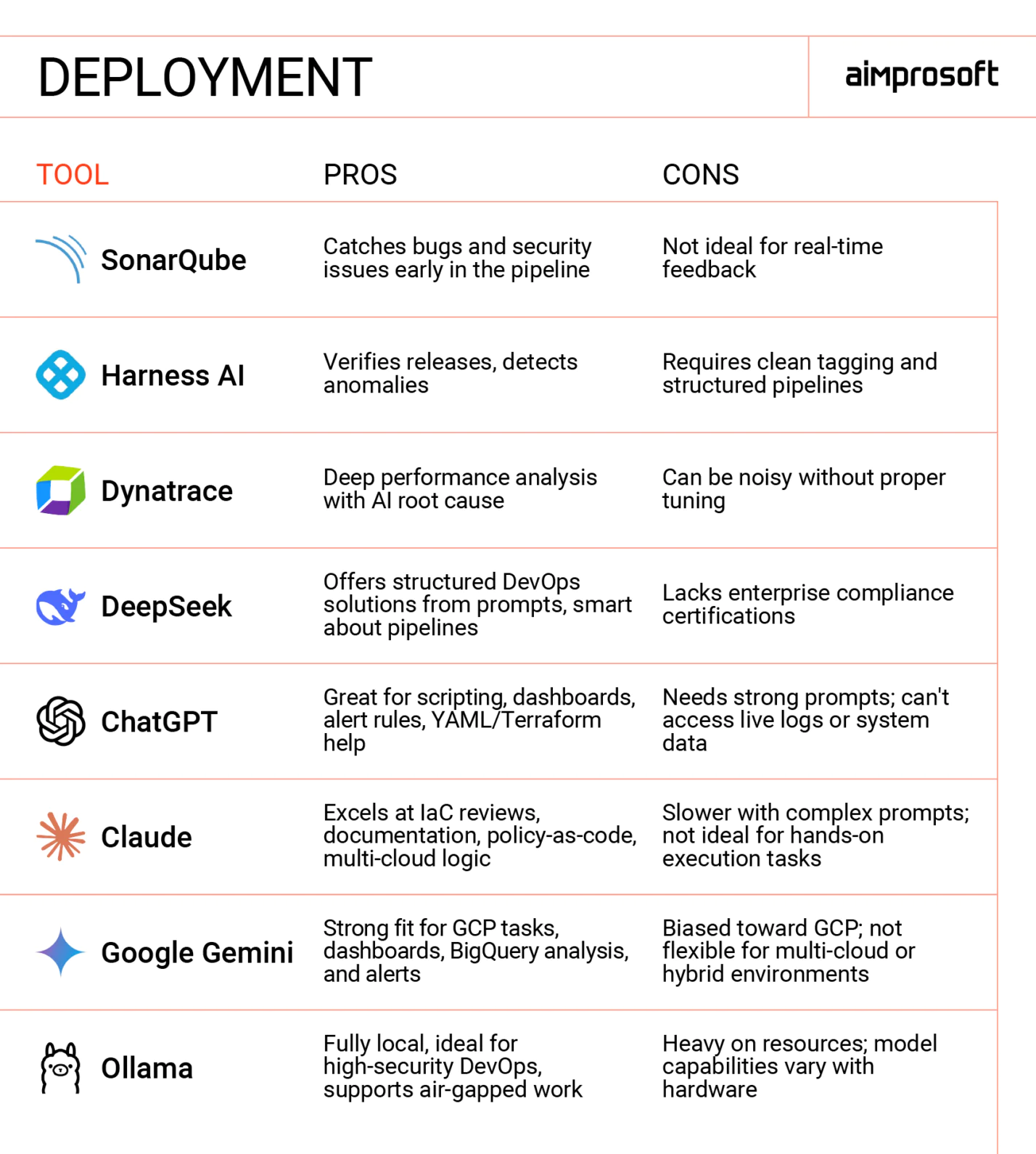
SonarQube
Use cases: Analyzing code quality, catching potential issues, and enforcing team-wide standards. While it works well even without AI, the AI-assisted features help surface problems faster and add extra context during reviews.
Why we use it: It helps catch bugs, security issues, and messy code early in the CI/CD pipeline, making it a key part of maintaining a healthy, high-quality codebase. Even though it works well without AI, the new AI features help fix problems faster and understand them more easily. Not using these AI features would mean missing out on some great benefits.
Limitations: Not truly real-time; better suited for pipeline-integrated analysis than for rapid, in-editor iteration.
Privacy: The tool can be self-hosted for full control or used in the cloud with strong encryption and compliance policies. SonarQube follows industry best practices for data protection.
Harness AI
Use cases: Automating deployments, detecting anomalies, and verifying releases across environments.
Why we use it: Automates deployment validation and reduces manual checks, especially across complex environments.
Limitations: Requires consistent tagging and clean pipelines for best performance.
Privacy: Access is tightly controlled, with encrypted storage and regular backups to protect deployment data.
Dynatrace
Use cases: Monitoring application performance with AI, sending smart alerts, and recommending self-healing actions for faster recovery.
Why we use it: It offers deep insights into production environments with AI-driven root cause analysis and is ideal for complex, multi-service architectures.
Limitations: Requires onboarding and tuning to avoid alert fatigue or false positives.
Privacy: Your performance data is encrypted using industry-standard security protocols and anonymized for compliance and secure insights.
DeepSeek
Use cases: Generating Kubernetes manifests, refactoring Jenkins pipelines, debugging build scripts, and improving CI/CD configuration with minimal input. It’s also handy for code cleanup, readability improvements, and giving context-aware suggestions for infrastructure automation.
Why we use it: It provides structured, ready-to-run solutions with very little prompting. It really “gets” DevOps-specific contexts, like tool versions and pipeline structures. Plus, it offers clear documentation and proactively suggests improvements, which is super helpful.
Limitations: While very capable out of the box, DeepSeek’s outputs still require validation in production-like environments. Compared to ChatGPT, it’s more proactive but can sometimes make assumptions about requirements that don’t match the specific use case.
Privacy: DeepSeek allows for local deployment, which is advantageous for keeping infrastructure code and DevOps data in-house. While promising for general DevOps automation and internal tools, it lacks enterprise-grade audit trails and compliance certifications.
ChatGPT
Use cases: Writing and debugging scripts (Bash, Python, PowerShell), generating CI/CD pipeline configurations, reviewing code snippets. It’s great for explaining infrastructure concepts and assisting with YAML, Terraform, and Docker configurations.
Why we use it: ChatGPT is excellent for creating custom monitoring dashboards in Grafana and DataDog, and generating Prometheus alerting rules. It’s great for creating log parsing scripts and building automated incident detection workflows. It’s also strong at explaining complex metrics and creating SLI/SLO definitions.
Limitations: Quality heavily depends on prompt engineering — vague prompts give generic results. Complex, multi-step DevOps workflows often require iterative refinement. Can’t access real-time system data or logs.
Privacy: Enterprise plans offer enhanced data controls and don’t use conversations for training. API usage provides better data control than a web interface.
Claude
Use cases: Analyzing complex infrastructure-as-code (IaC) projects, refactoring pipeline logic, explaining DevOps architecture decisions, performing comprehensive code reviews, and generating detailed documentation or SOPs.
Why we use it: Works best for analyzing Helm charts and Kubernetes policy reviews. Helpful documenting GitOps workflows and architectural decisions for container platforms. We also use it for infrastructure reviews, IaC documentation, policy-as-code tasks, and exploring multi-cloud deployment strategies.
Limitations: Can be slower with complex prompts and isn’t suited for real-time code execution compared to some alternatives.
Privacy: While it’s well-suited for writing compliance-related documentation and analyzing infrastructure policies, it should be used cautiously for sensitive data. Anthropic emphasizes safety and data handling standards, but it may not meet strict enterprise compliance needs out of the box.
Google Gemini
Use cases: Automating tasks on Google Cloud Platform (GCP), optimizing resource configurations, planning Terraform deployments specific to GCP, managing GKE clusters, and refining Cloud Build pipelines.
Why we use it: Gemini is well-suited for the Google Cloud Operations Suite, especially for setting up Cloud Monitoring dashboards and integrating with GCP logging and BigQuery for in-depth analysis. It’s also helpful for tracking costs and generating alerts related to resource optimization.
Limitations: Less effective outside the Google Cloud ecosystem. Responses often heavily reference Google Cloud solutions, even when a multi-cloud approach might be better. Limited creativity for non-GCP DevOps challenges.
Privacy: Gemini benefits from Google’s enterprise-grade security controls, but since it’s cloud-based, data residency and compliance requirements should be reviewed before using it with sensitive infrastructure data.
Ollama
Use cases: Analyzing sensitive infrastructure configurations, creating internal documentation with proprietary information, debugging scripts with production data, and developing custom DevOps tooling in air-gapped environments.
Why we use it: Offers full data privacy and control. Everything runs locally on your infrastructure, with no internet dependency. It integrates well with existing DevOps toolchains and CI/CD pipelines and supports multiple open-source models (Llama, CodeLlama, Mistral, etc.).
Limitations: Requires significant computational resources (GPU recommended for larger models). Model capabilities may lag cutting-edge cloud alternatives. Performance varies significantly based on hardware configuration.
Privacy: It supports strict data residency and air-gapped requirements, making it suitable for high-security environments.
AI use case: DevOps for a large-scale partner
Nothing kills team morale like fragile deployments. One of our partners was dealing with CI/CD pipelines that were slow, unreliable, and frankly dangerous — no static analysis, no security checks, and zero rollback strategy. We overhauled their entire deployment process: SonarQube for code quality, caching and parallel execution for speed, and Canary/blue-green deployments for safety. How did it turn out? Build times dropped significantly, rollback risks were minimized, and their DevOps team could finally sleep well on Friday nights.
Maintenance and observation
After deployment, your work isn’t truly over; it’s just beginning a new phase. From here, it’s all about keeping things stable, spotting issues early, and staying fast without causing damage.
In this phase, AI assists with root cause analysis, performance prediction, and cloud resource optimization.
Here are the tools we use to keep systems running smoothly and internal knowledge accessible.
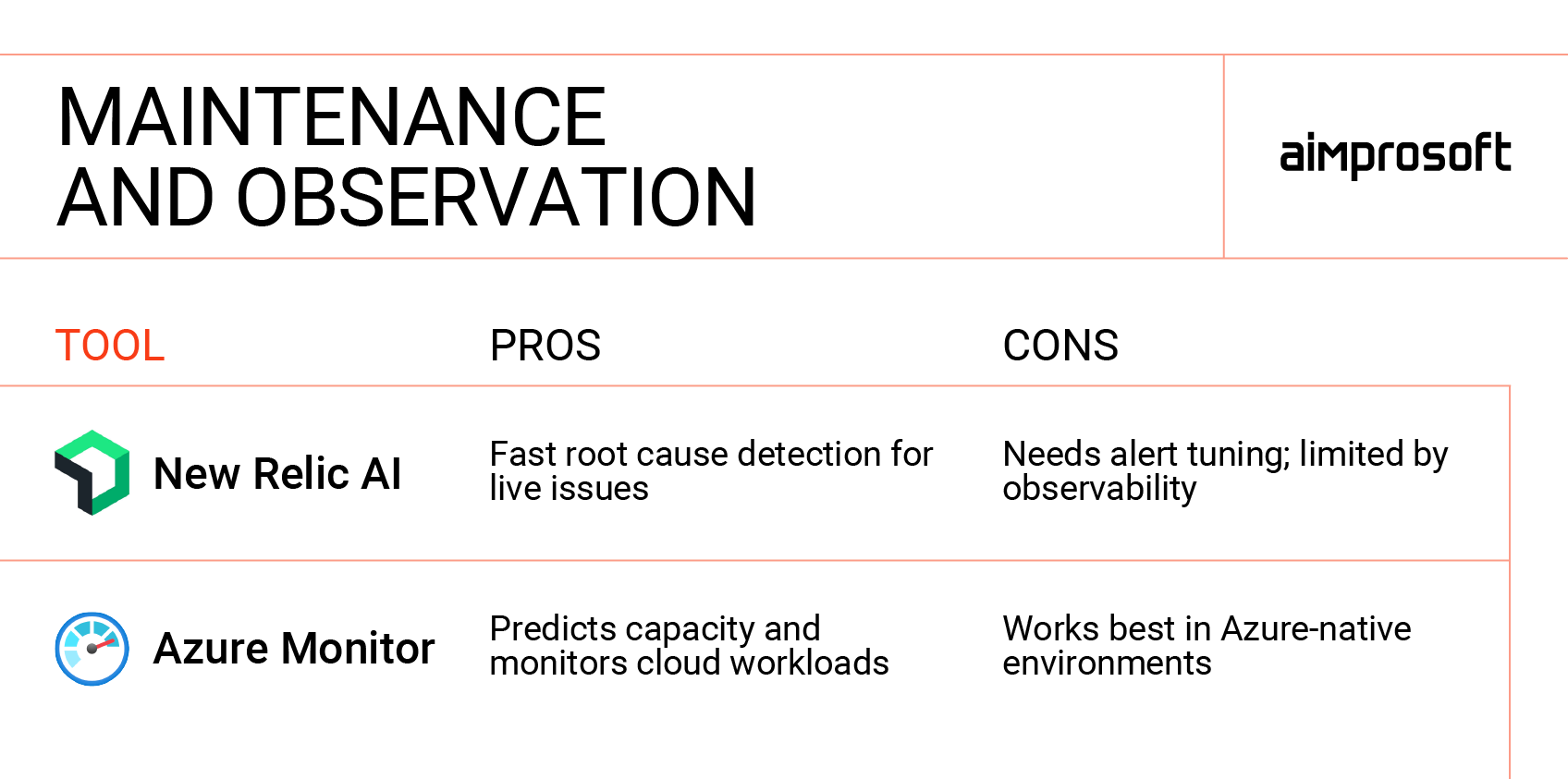
New Relic AI
Use cases: Analyzing root causes, detecting anomalies, and monitoring system health in real-time.
Why we use it: New Relic helps us spot and fix performance issues faster — especially in complex, distributed systems.
Limitations: The tool requires thoughtful and alert tuning to avoid noise; it is limited to the scope of observable data.
Privacy: Fully encrypted and compliant with GDPR and CCPA to ensure system data stays secure and accessible only to your team.
Azure Monitor (with AIOps)
Use cases: Monitoring resources, detecting anomalies, predicting capacity needs, and sending performance alerts.
Why we use it: Built-in AIOps help us catch infrastructure issues before they escalate across virtual machines, containers, and services.
Limitations: Works best when integrated tightly into the Azure ecosystem; less flexible across mixed cloud environments.
Privacy: Data is encrypted and managed under Microsoft’s enterprise cloud privacy policies; it is safe for sensitive infrastructure insights.
Documentation
Once your code is live, keeping documentation accurate and up to date becomes critical — especially for long-term maintainability and onboarding. Outdated docs slow teams down, lead to knowledge gaps and cause costly delays when systems need updates or debugging.
Yet writing and maintaining documentation can be too time-consuming and is often the first thing to slip during fast-moving development cycles. That’s where AI-powered tools come in, helping to generate structured documentation directly from your code, keep API specifications in sync, and transform legacy systems into readable, searchable knowledge bases.
Here are the tools we’ve used to make documentation easier and keep system knowledge available for all teams.
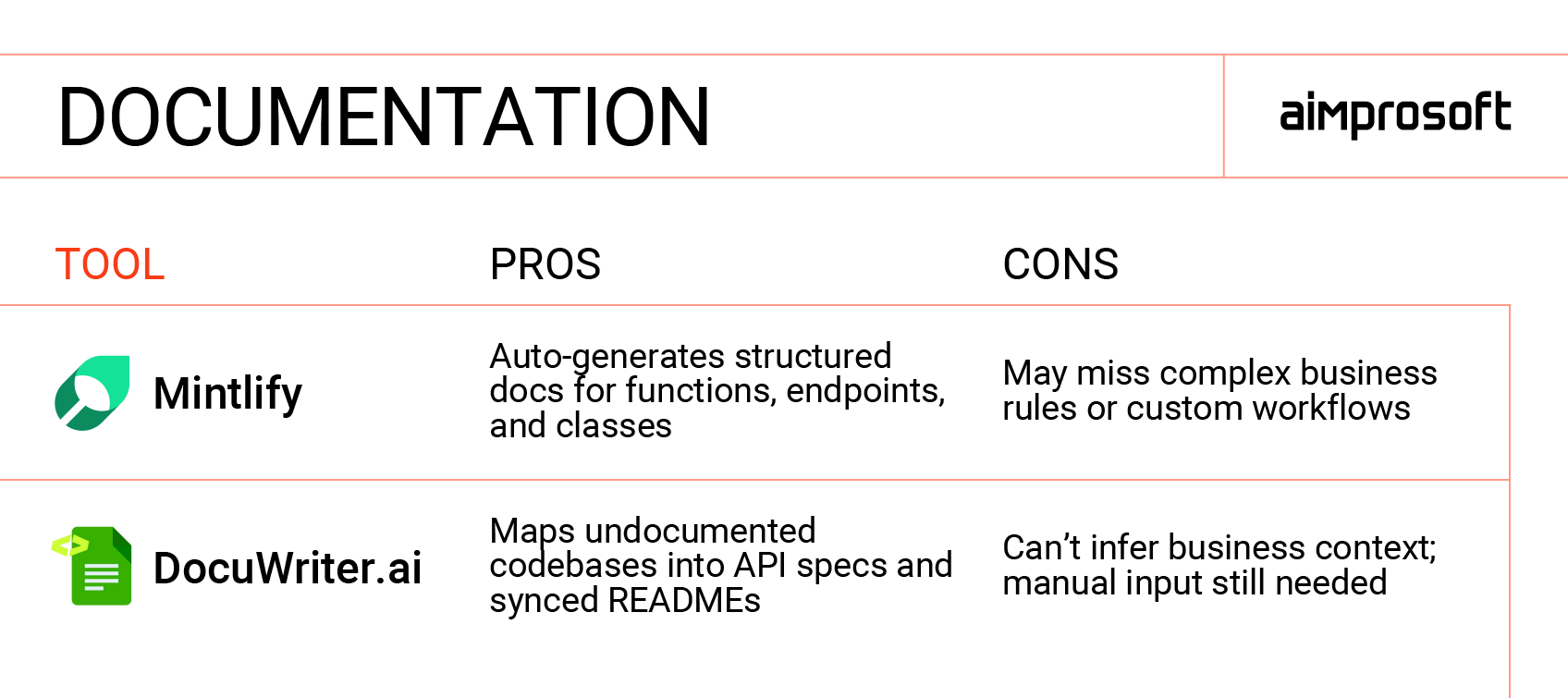
Mintlify
Use cases: Generating developer-facing documentation directly from codebases (e.g., functions, endpoints, classes).
Why we use it: It saves precious time creating structured documentation for new features. It’s particularly handy during team handovers or after large refactors, ensuring that our documentation keeps pace with our code changes.
Limitations: While Mintlify excels at parsing and documenting standard code constructs, it can sometimes struggle with more complex business rules or domain-specific workflows. If your code includes custom logic that isn’t clearly expressed in the code structure or naming, you might need to manually intervene to ensure accuracy.
Privacy: Documentation is stored securely, and for those with strict compliance needs, the enterprise plans offer no data retention and options for local or on-prem deployment.
DocuWriter.ai
Use cases: Converting undocumented legacy codebases into structured API documentation, maintaining consistent documentation across microservices, and generating README files that stay synced with the code.
Why we use it: Excels at mapping internal code structure, even in large, undocumented systems. It automatically detects function relationships, cross-service calls, and hidden dependencies, helping teams understand how code works without manual code exploration.
Limitations: While the tool excels at handling technical structures, it’s important to note that it can’t infer business intent or domain-specific logic that isn’t explicitly coded. Therefore, teams still need to manually add descriptions for workflows, business rules, or decision-making processes that exist outside the code.
Privacy: It offers local deployment options and isolated processing environments, which are critical for handling sensitive codebases. Additionally, all source data is automatically purged after analysis, providing an extra layer of security and compliance.
AI use case: maintenance for a telecom partner
Here’s a number that’ll make you wince: 2,600 hours per year. That’s how much time our partner’s team was spending just answering internal questions about their undocumented microservices. Knowledge was trapped in developers’ heads, and every new team member meant weeks of ramping up. We automated their documentation process using AI tools like Javadoc, TypeDoc, and OpenAPI. Within six months, internal support time was reduced by 20%. By the end of the year, the total reduction reached 15–20%, allowing senior developers to spend more time coding and less time supporting.
Sum up
AI tool rankings change overnight. New features launch, models improve, and yesterday’s favorite becomes tomorrow’s outdated choice. But teams that know how to implement these tools effectively and adapt as they evolve are what truly matters.
If you’re looking for a team that knows how to leverage AI to achieve better results— let’s talk.




